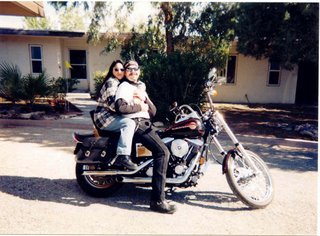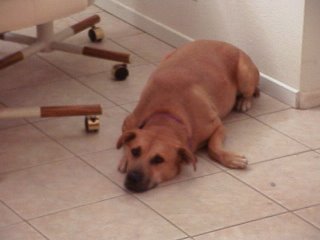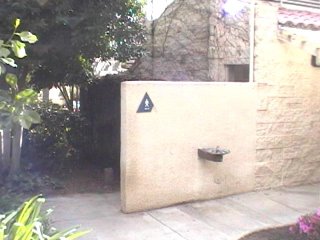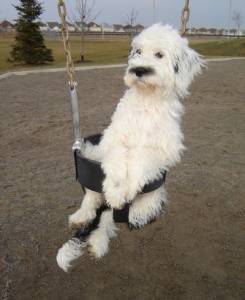Misha Learns To Poop In The Toilet
While temporarily using a coworker's computer, I came across this bit of information on how to toilet train your cat. Now if I could get my dogs to do this, it would sure save alot of shoveling time. Heh. If any of you read this and are able to train your kitty to do such, please let me know. And send pix because that last cat picture is hilarious. Happy Friday!
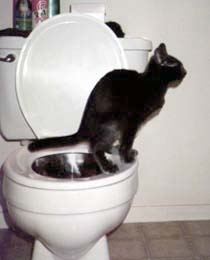 Ready? First start by training yourself ...
Ready? First start by training yourself ...
The very most important thing to remember is: Lid Up, Seat Down. Post a note on the back of the door or the lid of the toilet if you think you (or your housemates or guests) might forget. (Nowadays, if I have a guest who leaves the lid down, Misha will usually come and ask me to fix it, but you can't expect every cat to go to this much trouble. Besides, he's been using the toilet for more than six years now; when the whole idea was new to him he'd just as soon pee in the bathtub instead.) And if you are accustomed to closing the bathroom door when it's empty, you'll have to break that habit too.
Begin by moving the cat's current litter box from wherever it is to one side of the toilet. Make sure he knows where it is and uses it. Rest. Next put something — a stack of newspapers, a phone book, a cardboard box — under the litter box to raise it, say, about an inch. (Magazines are too slick; you don't want the litter box sliding around and making Felix feel insecure. Tape the litter box down if you need to.) Rest. Get another box or phone book and raise it a little higher. Rest. Continue this process until the bottom of the litter box is level with the top of the toilet seat. (For Misha I raised it about two inches per day.)
At the beginning of this process, your cat could just step into the box; later he began jumping up into it, until at some point he probably started jumping up onto the toilet seat first and stepping into the box from there. You've been diligently keeping the lid up and the seat down, of course, so by now your cat is thoroughly familiar with tromping around on the open toilet.
Lift the seat on your toilet and measure the inside diameter of the top of the bowl at its widest point. Venture forth and buy a metal mixing bowl of that diameter. Do not (I discovered this the hard way) substitute a plastic bowl. A plastic bowl will not support the cat's weight and will bend, dropping into the toilet bowl and spilling litter everywhere, not to mention startling hell out of the cat.
Now you move the litter box over so that it's sitting directly over the toilet seat. (If your cat has shown reluctance over previous changes, you might want to split this into two stages, moving it halfway onto the seat and then fully over.) Take away the stack of phone books or whatever. Rest.
Here's the cool part. Take away the litter box entirely. (Ta da!) Nestle the metal mixing bowl inside the toilet bowl and lower the seat. Fill the bowl with about two inches of litter (all of this is much easier if you have the tiny granules of litter that can be scooped out and flushed).
Naturally, any humans using the toilet at this point will want to remove the metal bowl prior to their own use and replace it afterward. The next week or two the whole process is likely to be something of an annoyance; if you begin to think it's not worth it, just remember that you will never have to clean a litter box again.
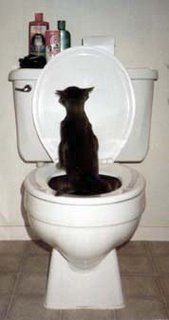
Naturally, any humans using the toilet at this point will want to remove the metal bowl prior to their own use and replace it afterward. The next week or two the whole process is likely to be something of an annoyance; if you begin to think it's not worth it, just remember that you will never have to clean a litter box again.
Misha's first attempt without the box. He scored two out of a possible four.
Watch your cat using the bathroom in the metal bowl. Count the number of feet he gets up on the toilet seat (as opposed to down in the bowl of litter). The higher the number, the luckier you are and the easier your job is going to be ...
...because next you have to teach him proper squatting posture. Catch him beginning to use the toilet as much of the time as possible and show him where his feet are supposed to go. Just lift them right out of the bowl and place them on the seat (front legs in the middle, hind legs on the outside). If he starts out with three or, heaven forbid, all four feet in the bowl, just get the front two feet out first. Praise him all over the place every time he completes the activity in this position.
(Misha is very doglike in that he craves approval and praise. If your cat is indifferent to this sort of thing, you can also reward him with small food treats and wean him from them later when the toilet behavior has 'set.' Just keep the treats as small and infrequent as possible — half a Pounce or similar treat per occasion should be plenty.)
When he is regularly using the toilet with his front feet out (and some cats naturally start from this position), begin lifting a hind foot out and placing it on the seat outside the front paws. Felix will probably find this awkward at first and try to replace the foot in the litter. Be persistent. Move that foot four times in a row if you have to, until it stays there. Praise and/or treat.
Misha demonstrates proper squatting posture. Note the look of firm concentration.
Repeat with the other hind foot, until your cat learns to balance in that squat. (There will actually be two different squats, a low one for urine elimination and a high one for bowel movements.) Once he's getting all four feet regularly on the seat, it's all downhill from here.
Which is fortunate, because the last bit is also the most unpleasant. I suggest that you postpone this stage until you have at least a weekend, and preferably several days, when you (or another responsible party) will be at home most of the time. I skipped through this part in about two days; I only hope that your cat allows you to move along that fast.
Begin reducing the litter in the bowl. Go as fast as he'll feel comfortable with, because as the litter decreases, the odor increases. You'll want to be home at this point so that you can praise him and dump out the contents of the bowl immediately after he's finished, to minimize both the smell and the possibility that your cat, in a confused attempt to minimize the smell on his own, tries to cover it up with litter that no longer exists and ends up tracking unpleasantness into the rest of the house.
By the time you're down to a token teaspoonful of litter in the bottom of the bowl, your next-door neighbors will probably be aware of the precise instant your cat has used the toilet. This is as bad as it gets. The next time you rinse out the metal bowl, put a little bit of water in the bottom. Increase the water level each time, just as you decreased the litter level. Remember — if at any point Felix looks nervous enough about the change to give the whole thing up and take his business to the corner behind the door, back up a step or two and try the thing again more slowly.
Once the water in the mixing bowl is a couple of inches deep and your cat is comfortable with the whole thing, you get to perform the last bit of magic. Take the mixing bowl away, leaving the bare toilet. (Lid Up, Seat Down.)
Voila! Your cat is now toilet-trained.
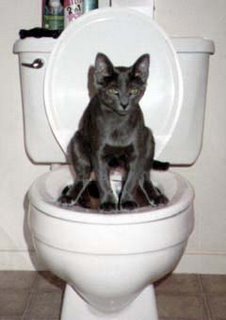
 Ready? First start by training yourself ...
Ready? First start by training yourself ...The very most important thing to remember is: Lid Up, Seat Down. Post a note on the back of the door or the lid of the toilet if you think you (or your housemates or guests) might forget. (Nowadays, if I have a guest who leaves the lid down, Misha will usually come and ask me to fix it, but you can't expect every cat to go to this much trouble. Besides, he's been using the toilet for more than six years now; when the whole idea was new to him he'd just as soon pee in the bathtub instead.) And if you are accustomed to closing the bathroom door when it's empty, you'll have to break that habit too.
Begin by moving the cat's current litter box from wherever it is to one side of the toilet. Make sure he knows where it is and uses it. Rest. Next put something — a stack of newspapers, a phone book, a cardboard box — under the litter box to raise it, say, about an inch. (Magazines are too slick; you don't want the litter box sliding around and making Felix feel insecure. Tape the litter box down if you need to.) Rest. Get another box or phone book and raise it a little higher. Rest. Continue this process until the bottom of the litter box is level with the top of the toilet seat. (For Misha I raised it about two inches per day.)
At the beginning of this process, your cat could just step into the box; later he began jumping up into it, until at some point he probably started jumping up onto the toilet seat first and stepping into the box from there. You've been diligently keeping the lid up and the seat down, of course, so by now your cat is thoroughly familiar with tromping around on the open toilet.
Lift the seat on your toilet and measure the inside diameter of the top of the bowl at its widest point. Venture forth and buy a metal mixing bowl of that diameter. Do not (I discovered this the hard way) substitute a plastic bowl. A plastic bowl will not support the cat's weight and will bend, dropping into the toilet bowl and spilling litter everywhere, not to mention startling hell out of the cat.
Now you move the litter box over so that it's sitting directly over the toilet seat. (If your cat has shown reluctance over previous changes, you might want to split this into two stages, moving it halfway onto the seat and then fully over.) Take away the stack of phone books or whatever. Rest.
Here's the cool part. Take away the litter box entirely. (Ta da!) Nestle the metal mixing bowl inside the toilet bowl and lower the seat. Fill the bowl with about two inches of litter (all of this is much easier if you have the tiny granules of litter that can be scooped out and flushed).
Naturally, any humans using the toilet at this point will want to remove the metal bowl prior to their own use and replace it afterward. The next week or two the whole process is likely to be something of an annoyance; if you begin to think it's not worth it, just remember that you will never have to clean a litter box again.

Naturally, any humans using the toilet at this point will want to remove the metal bowl prior to their own use and replace it afterward. The next week or two the whole process is likely to be something of an annoyance; if you begin to think it's not worth it, just remember that you will never have to clean a litter box again.
Misha's first attempt without the box. He scored two out of a possible four.
Watch your cat using the bathroom in the metal bowl. Count the number of feet he gets up on the toilet seat (as opposed to down in the bowl of litter). The higher the number, the luckier you are and the easier your job is going to be ...
...because next you have to teach him proper squatting posture. Catch him beginning to use the toilet as much of the time as possible and show him where his feet are supposed to go. Just lift them right out of the bowl and place them on the seat (front legs in the middle, hind legs on the outside). If he starts out with three or, heaven forbid, all four feet in the bowl, just get the front two feet out first. Praise him all over the place every time he completes the activity in this position.
(Misha is very doglike in that he craves approval and praise. If your cat is indifferent to this sort of thing, you can also reward him with small food treats and wean him from them later when the toilet behavior has 'set.' Just keep the treats as small and infrequent as possible — half a Pounce or similar treat per occasion should be plenty.)
When he is regularly using the toilet with his front feet out (and some cats naturally start from this position), begin lifting a hind foot out and placing it on the seat outside the front paws. Felix will probably find this awkward at first and try to replace the foot in the litter. Be persistent. Move that foot four times in a row if you have to, until it stays there. Praise and/or treat.
Misha demonstrates proper squatting posture. Note the look of firm concentration.
Repeat with the other hind foot, until your cat learns to balance in that squat. (There will actually be two different squats, a low one for urine elimination and a high one for bowel movements.) Once he's getting all four feet regularly on the seat, it's all downhill from here.
Which is fortunate, because the last bit is also the most unpleasant. I suggest that you postpone this stage until you have at least a weekend, and preferably several days, when you (or another responsible party) will be at home most of the time. I skipped through this part in about two days; I only hope that your cat allows you to move along that fast.
Begin reducing the litter in the bowl. Go as fast as he'll feel comfortable with, because as the litter decreases, the odor increases. You'll want to be home at this point so that you can praise him and dump out the contents of the bowl immediately after he's finished, to minimize both the smell and the possibility that your cat, in a confused attempt to minimize the smell on his own, tries to cover it up with litter that no longer exists and ends up tracking unpleasantness into the rest of the house.
By the time you're down to a token teaspoonful of litter in the bottom of the bowl, your next-door neighbors will probably be aware of the precise instant your cat has used the toilet. This is as bad as it gets. The next time you rinse out the metal bowl, put a little bit of water in the bottom. Increase the water level each time, just as you decreased the litter level. Remember — if at any point Felix looks nervous enough about the change to give the whole thing up and take his business to the corner behind the door, back up a step or two and try the thing again more slowly.
Once the water in the mixing bowl is a couple of inches deep and your cat is comfortable with the whole thing, you get to perform the last bit of magic. Take the mixing bowl away, leaving the bare toilet. (Lid Up, Seat Down.)
Voila! Your cat is now toilet-trained.

